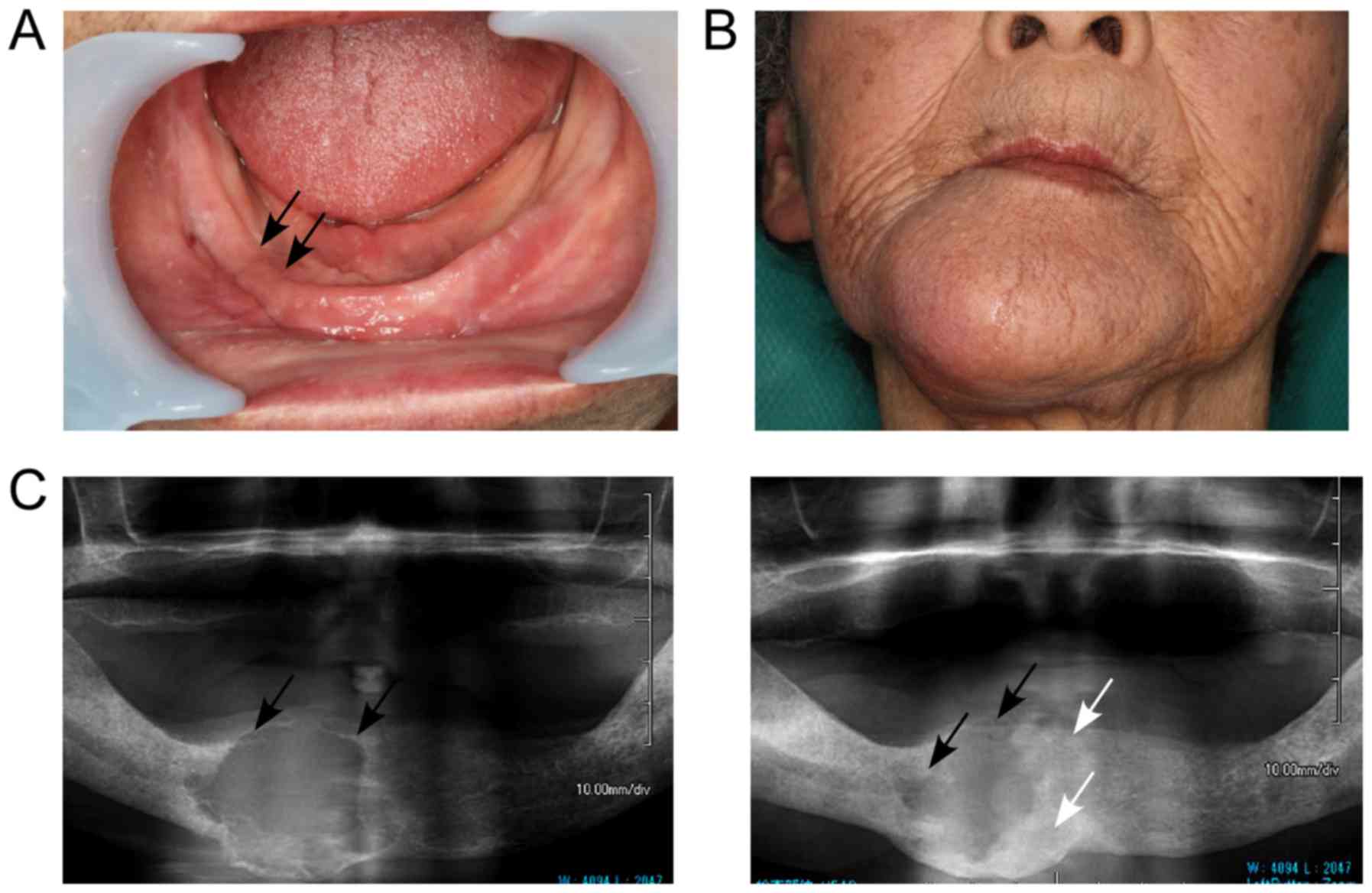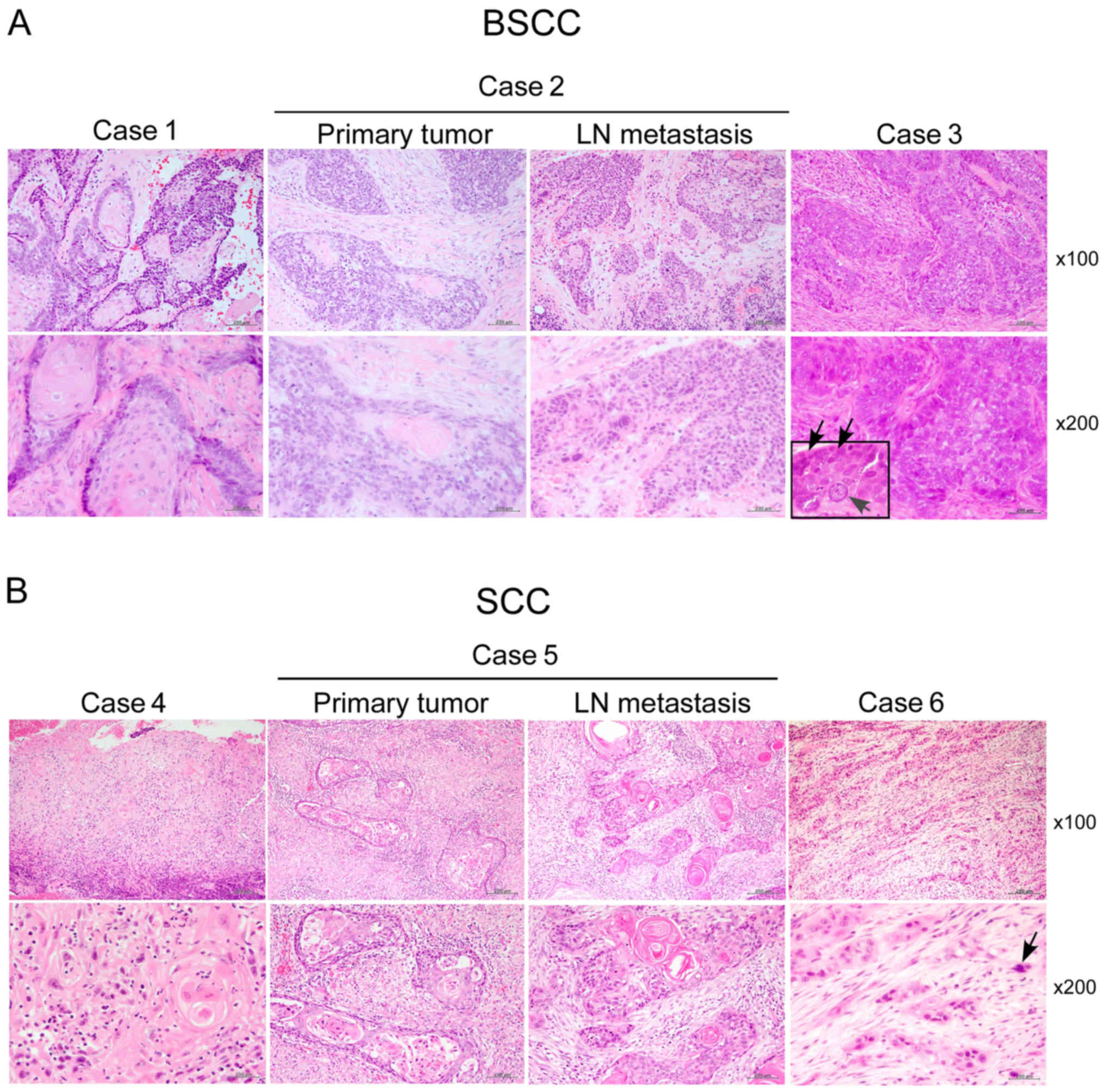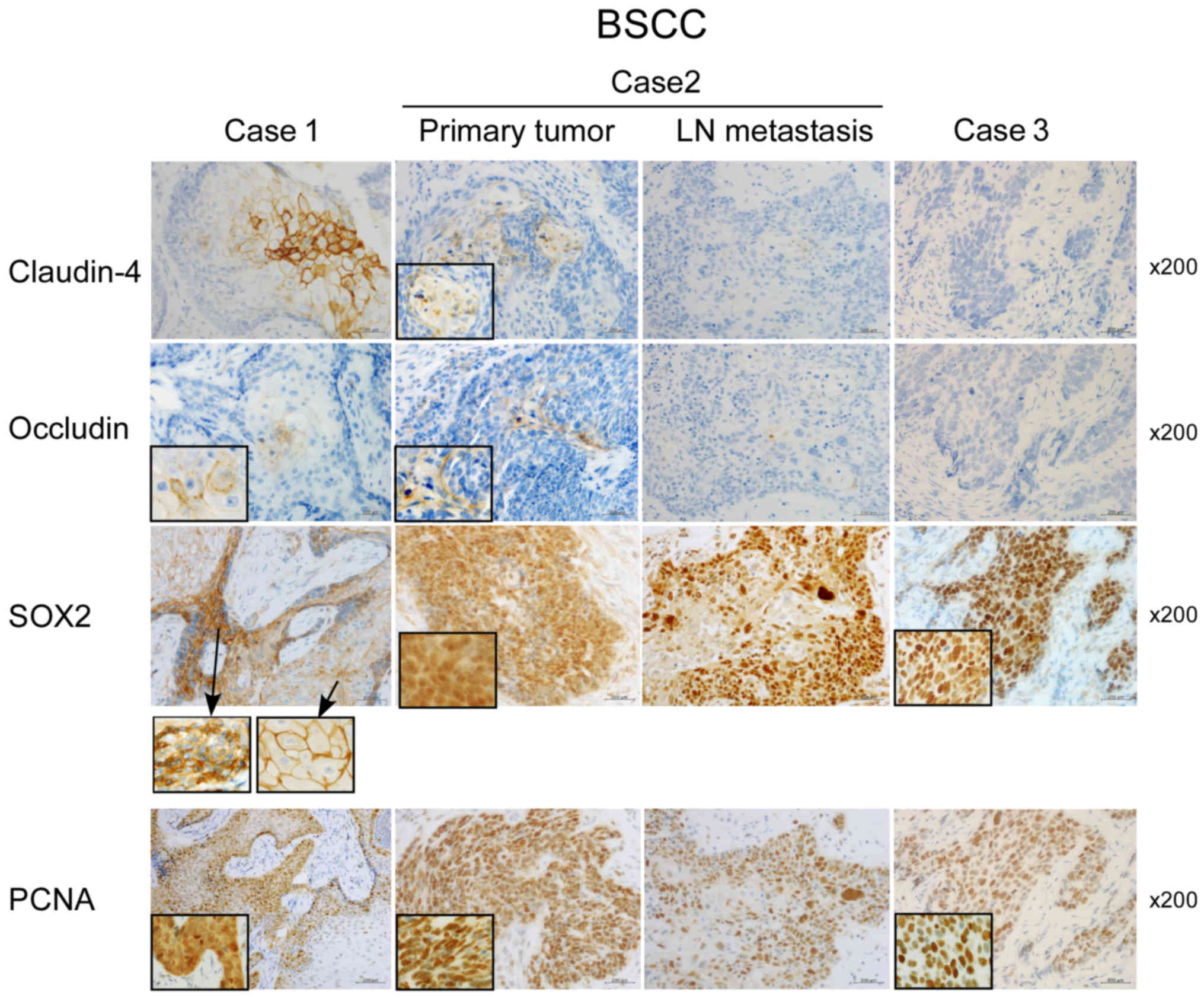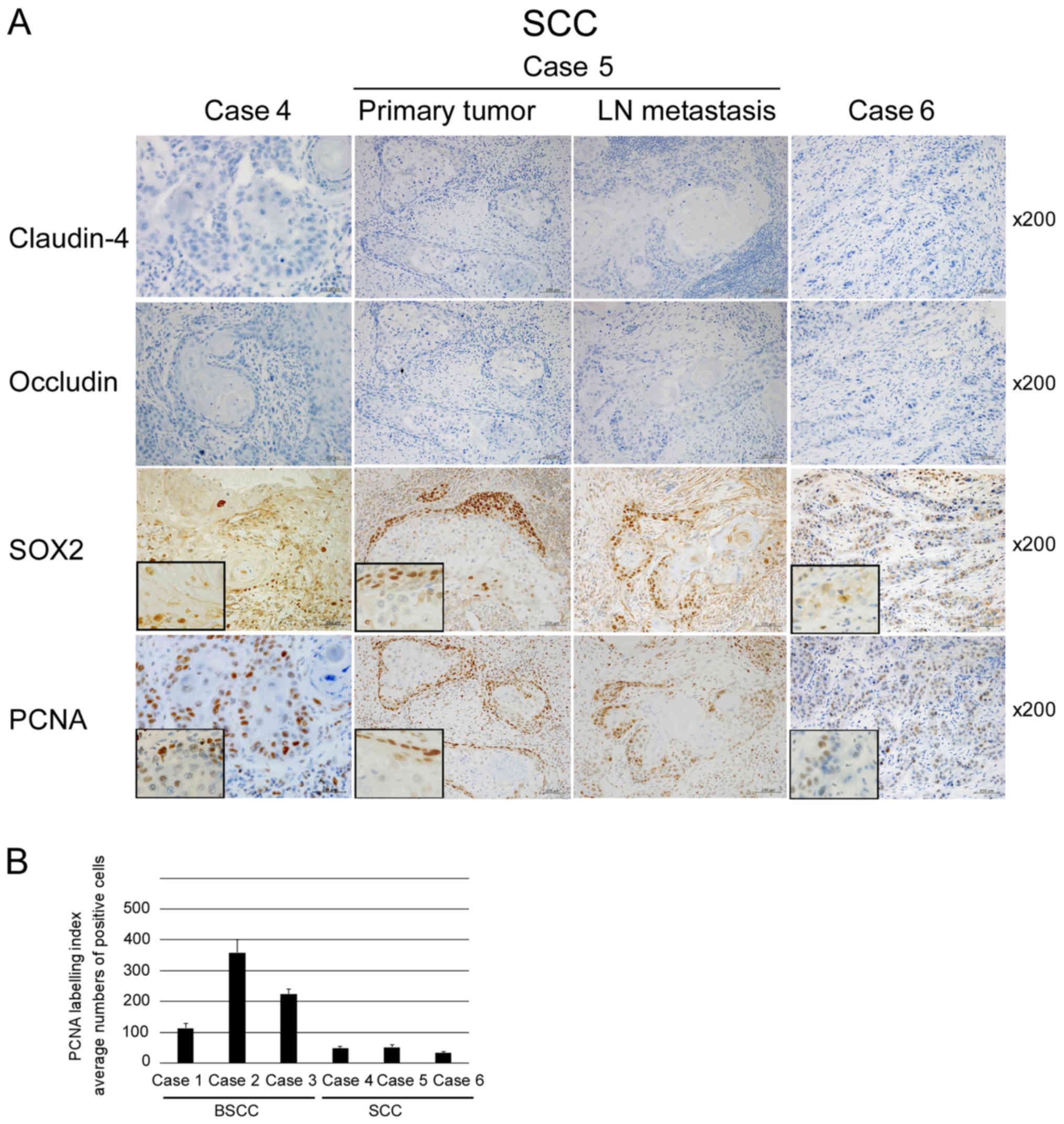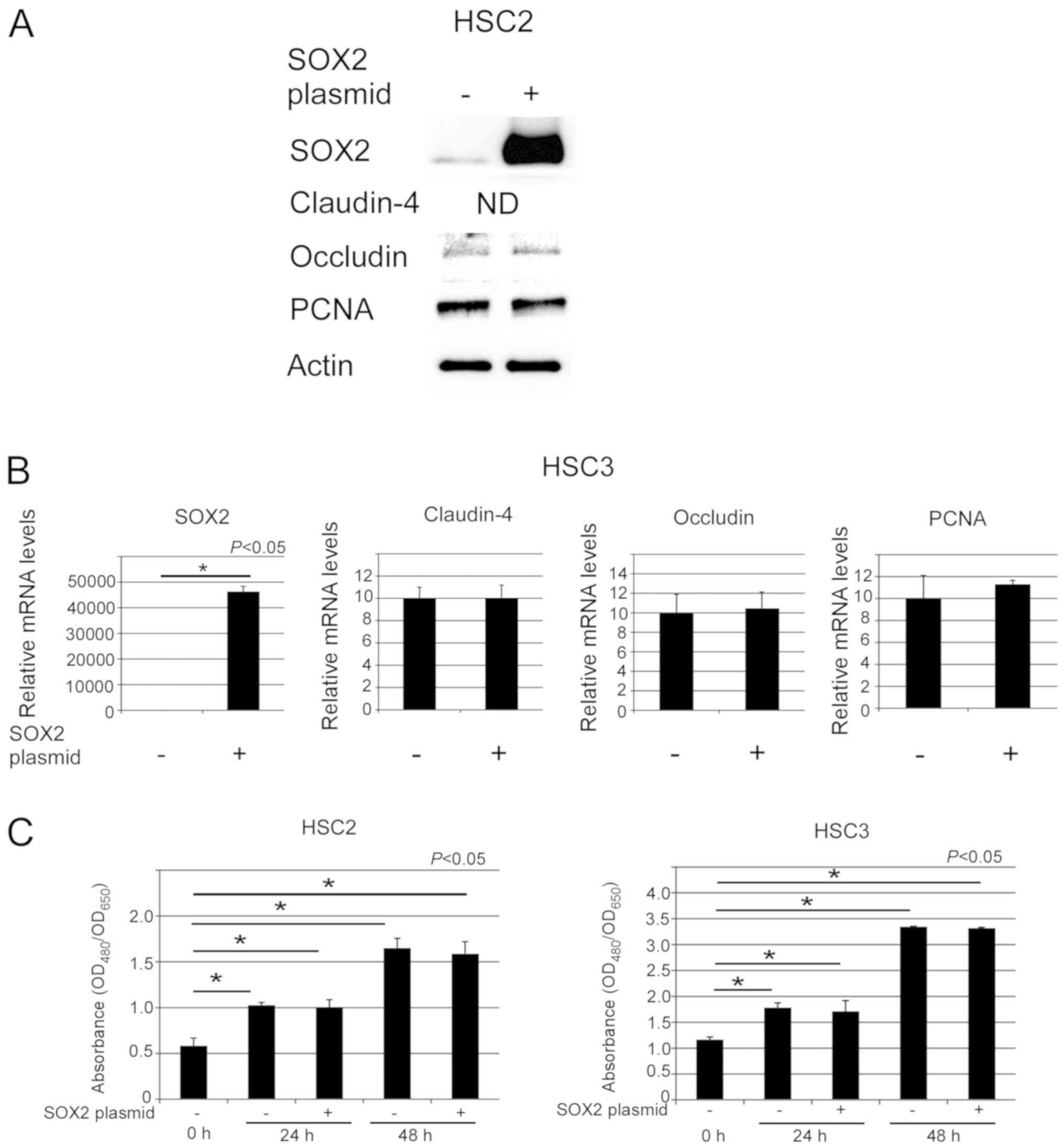|
1
|
Fritsch VA, Gerry DR and Lentsch EJ:
Basaloid squamous cell carcinoma of the oral cavity: An analysis of
92 cases. Laryngoscope. 124:1573–1578. 2014. View Article : Google Scholar : PubMed/NCBI
|
|
2
|
Thariat J, Badoual C, Faure C, Butori C,
Marcy PY and Righini CA: Basaloid squamous cell carcinoma of the
head and neck: Role of HPV and implication in treatment and
prognosis. J Clin Pathol. 63:857–866. 2010. View Article : Google Scholar : PubMed/NCBI
|
|
3
|
Ereño C, Gaafar A, Garmendia M,
Etxezarraga C, Bilbao FJ and López JI: Basaloid squamous cell
carcinoma of the head and neck: A clinicopathological and follow-up
study of 40 cases and review of the literature. Head Neck Pathol.
2:83–91. 2008. View Article : Google Scholar : PubMed/NCBI
|
|
4
|
Shen W, Sakamoto N and Yang L:
Cause-specific mortality prediction model for patients with
basaloid squamous cell carcinomas of the head and neck: A competing
risk analysis. J Cancer. 9:4009–4017. 2018. View Article : Google Scholar : PubMed/NCBI
|
|
5
|
Wain SL, Kier R, Vollmer RT and Bossen EH:
Basaloid-squamous carcinoma of the tongue, hypopharynx, and larynx:
Report of 10 cases. Hum Pathol. 17:1158–1166. 1986. View Article : Google Scholar : PubMed/NCBI
|
|
6
|
Luna MA, el Naggar A, Parichatikanond P,
Weber RS and Batsakis JG: Basaloid squamous carcinoma of the upper
aerodigestive tract. Clinicopathologic and DNA flow cytometric
analysis. Cancer. 66:537–542. 1990. View Article : Google Scholar : PubMed/NCBI
|
|
7
|
Sampaio-Góes FC, Oliveira DT, Dorta RG,
Nonogaki S, Landman G, Nishimoto IN and Kowalski LP: Expression of
PCNA, p53, Bax, and Bcl-X in oral poorly differentiated and
basaloid squamous cell carcinoma: Relationships with prognosis.
Head Neck. 27:982–989. 2005. View Article : Google Scholar : PubMed/NCBI
|
|
8
|
Coletta RD, Cotrim P, Vargas PA, Villalba
H, Pires FR, de Moraes M and de Almeida OP: Basaloid squamous
carcinoma of the oral cavity: Report of 2 cases and study of AgNOR,
PCNA, p53, and MMP expression. Oral Surg Oral Med Oral Pathol Oral
Radiol Endod. 91:563–569. 2001. View Article : Google Scholar : PubMed/NCBI
|
|
9
|
Pereira CH, Morais MO, Martins AF, Soares
MQ, Alencar Rde C, Batista AC, Leles CR and Mendonça EF: Expression
of adhesion proteins (E-cadherin and β-catenin) and cell
proliferation (Ki-67) at the invasive tumor front in conventional
oral squamous cell and basaloid squamous cell carcinomas. Arch Oral
Biol. 61:8–15. 2016. View Article : Google Scholar : PubMed/NCBI
|
|
10
|
Sappayatosok K and Phattarataratip E:
Overexpression of claudin-1 is associated with advanced clinical
stage and invasive pathologic characteristics of oral squamous cell
carcinoma. Head Neck Pathol. 9:173–180. 2015. View Article : Google Scholar : PubMed/NCBI
|
|
11
|
Phattarataratip E and Sappayatosok K:
Expression of claudin-5, claudin-7 and occludin in oral squamous
cell carcinoma and their clinico-pathological significance. J Clin
Exp Dent. 8:e299–e306. 2016.PubMed/NCBI
|
|
12
|
Wu Y, Sato F, Yamada T, Bhawal UK,
Kawamoto T, Fujimoto K, Noshiro M, Seino H, Morohashi S, Hakamada
K, et al: The BHLH transcription factor DEC1 plays an important
role in the epithelial-mesenchymal transition of pancreatic cancer.
Int J Oncol. 41:1337–1346. 2012. View Article : Google Scholar : PubMed/NCBI
|
|
13
|
Sato F, Kohsaka A, Takahashi K, Otao S,
Kitada Y, Iwasaki Y and Muragaki Y: Smad3 and Bmal1 regulate p21
and S100A4 expression in myocardial stromal fibroblasts via TNF-α.
Histochem Cell Biol. 148:617–624. 2017. View Article : Google Scholar : PubMed/NCBI
|
|
14
|
Sato F, Muragaki Y and Zhang Y: DEC1
negatively regulates AMPK activity via LKB1. Biochem Biophys Res
Commun. 467:711–716. 2015. View Article : Google Scholar : PubMed/NCBI
|
|
15
|
Livak KJ and Schmittgen TD: Analysis of
relative gene expression data using real-time quantitative PCR and
the 2(-Delta Delta C(T)) method. Methods. 25:402–408. 2001.
View Article : Google Scholar : PubMed/NCBI
|
|
16
|
Peddapell K, Rao GV, Sravya T and Ravipati
S: Basaloid squamous cell carcinoma: Report of two rare cases and
review of literature. J Oral Maxillofac Pathol. 22:2852018.
View Article : Google Scholar
|
|
17
|
Heera R, Ayswarya T, Padmakumar SK and
Ismayil P: Basaloid squamous cell carcinoma of oral cavity: Report
of two cases. J Oral Maxillofac Pathol. 20:5452016. View Article : Google Scholar : PubMed/NCBI
|
|
18
|
Patel PN, Mutalik VS, Rehani S and
Radhakrishnan R: Basaloid squamous cell carcinoma of oral cavity
with incongruent clinical course. BMJ Case Rep. 2013.bcr 2013200441
2013. View Article : Google Scholar
|
|
19
|
Maebayashi T, Ishibashi N, Aizawa T,
Sakaguchi M, Taku H, Ohhara M, Takimoto T and Tanaka Y: A
long-surviving patient with advanced esophageal basaloid squamous
cell carcinoma treated only with radiotherapy: Case report and
literature review. BMC Gastroenterol. 17:1512017. View Article : Google Scholar : PubMed/NCBI
|
|
20
|
Takubo K, Mafune K, Tanaka Y, Miyama T and
Fujita K: Basaloid-squamous carcinoma of the esophagus with marked
deposition of basement membrane substance. Acta Pathol Jpn.
41:59–64. 1991.PubMed/NCBI
|
|
21
|
Resnick MB, Konkin T, Routhier J, Sabo E
and Pricolo VE: Claudin-1 is a strong prognostic indicator in stage
II colonic cancer: A tissue microarray study. Mod Pathol.
18:511–518. 2005. View Article : Google Scholar : PubMed/NCBI
|
|
22
|
Sheehan GM, Kallakury BV, Sheehan CE,
Fisher HA, Kaufman RP Jr and Ross JS: Loss of claudins-1 and −7 and
expression of claudins-3 and −4 correlate with prognostic variables
in prostatic adenocarcinomas. Hum Pathol. 38:564–569. 2007.
View Article : Google Scholar : PubMed/NCBI
|
|
23
|
Lourenço SV, Coutinho-Camillo CM, Buim ME,
Pereira CM, Carvalho AL, Kowalski LP and Soares FA: Oral squamous
cell carcinoma: Status of tight junction claudins in the different
histopathological patterns and relationship with clinical
parameters. A tissue-microarray-based study of 136 cases. J Clin
Pathol. 63:609–614. 2010. View Article : Google Scholar : PubMed/NCBI
|
|
24
|
Martin TA, Mansel RE and Jiang WG: Loss of
occludin leads to the progression of human breast cancer. Int J Mol
Med. 26:723–734. 2010. View Article : Google Scholar : PubMed/NCBI
|
|
25
|
Yu GY, Gao Y, Peng X, Chen Y, Zhao FY and
Wu MJ: A clinicopathologic study on basaloid squamous cell
carcinoma in the oral and maxillofacial region. Int J Oral
Maxillofac Surg. 37:1003–1008. 2008. View Article : Google Scholar : PubMed/NCBI
|
|
26
|
Patil S, Rao RS, Ganavi BS and Majumdar B:
Natural sweeteners as fixatives in histopathology: A longitudinal
study. J Nat Sci Biol Med. 6:67–70. 2015. View Article : Google Scholar : PubMed/NCBI
|
|
27
|
Wang H, Zhou Y, Liu Q, Xu J and Ma Y:
Prognostic value of SOX2, Cyclin D1, p53, and ki-67 in patients
with esophageal squamous cell carcinoma. Onco Targets Ther.
11:5171–5181. 2018. View Article : Google Scholar : PubMed/NCBI
|
|
28
|
Wuebben EL, Wilder PJ, Cox JL, Grunkemeyer
JA, Caffrey T, Hollingsworth MA and Rizzino A: SOX2 functions as a
molecular rheostat to control the growth, tumorigenicity and drug
responses of pancreatic ductal adenocarcinoma cells. Oncotarget.
7:34890–34906. 2016. View Article : Google Scholar : PubMed/NCBI
|
|
29
|
Chung JH, Jung HR, Jung AR, Lee YC, Kong
M, Lee JS and Eun YG: SOX2 activation predicts prognosis in
patients with head and neck squamous cell carcinoma. Sci Rep.
8:16772018. View Article : Google Scholar : PubMed/NCBI
|
|
30
|
Yang N, Hui L, Wang Y, Yang H and Jiang X:
SOX2 promotes the migration and invasion of laryngeal cancer cells
by induction of MMP-2 via the PI3K/Akt/mTOR pathway. Oncol Rep.
31:2651–2659. 2014. View Article : Google Scholar : PubMed/NCBI
|
|
31
|
Girouard SD, Laga AC, Mihm MC, Scolyer RA,
Thompson JF, Zhan Q, Widlund HR, Lee CW and Murphy GF: SOX2
contributes to melanoma cell invasion. Lab Invest. 92:362–370.
2012. View Article : Google Scholar : PubMed/NCBI
|
|
32
|
Liu X, Qiao B, Zhao T, Hu F, Lam AK and
Tao Q: Sox2 promotes tumor aggressiveness and
epithelial-mesenchymal transition in tongue squamous cell
carcinoma. Int J Mol Med. 42:1418–1426. 2018.PubMed/NCBI
|
|
33
|
Han X, Fang X, Lou X, Hua D, Ding W, Foltz
G, Hood L, Yuan Y and Lin B: Silencing SOX2 induced
mesenchymal-epithelial transition and its expression predicts liver
and lymph node metastasis of CRC patients. PLoS One. 7:e413352012.
View Article : Google Scholar : PubMed/NCBI
|
|
34
|
Ramqvist T, Näsman A, Franzén B, Bersani
C, Alexeyenko A, Becker S, Haeggblom L, Kolev A, Dalianis T and
Munck-Wikland E: Protein expression in tonsillar and base of tongue
cancer and in relation to human papillomavirus (HPV) and clinical
outcome. Int J Mol Sci. 19:E9782018. View Article : Google Scholar : PubMed/NCBI
|
|
35
|
Näsman A, Bersani C, Lindquist D, Du J,
Ramqvist T and Dalianis T: Human papillomavirus and potentially
relevant biomarkers in tonsillar and base of tongue squamous cell
carcinoma. Anticancer Res. 37:5319–5328. 2017.PubMed/NCBI
|
|
36
|
Sajed DP, Faquin WC, Carey C, Severson EA,
H Afrogheh A, A Johnson C, Blacklow SC, Chau NG, Lin DT, Krane JF,
et al: Diffuse staining for activated NOTCH1 correlates with NOTCH1
mutation status and is associated with worse outcome in adenoid
cystic carcinoma. Am J Surg Pathol. 41:1473–1482. 2017. View Article : Google Scholar : PubMed/NCBI
|















